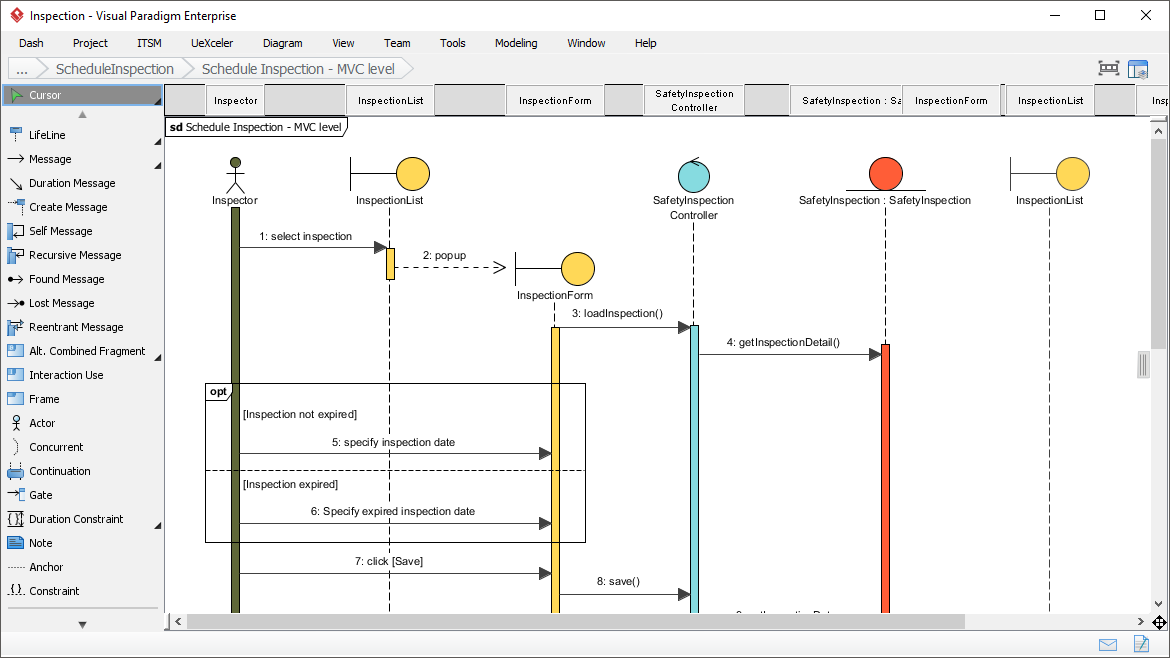🌟 Unlock Seamless Sequence Diagram with Visual Paradigm! 🌟
What is Sequence Diagram
A sequence diagram is a visual representation that illustrates the interactions and order of events between different components or objects in a system over a specific period. It’s a crucial tool in Unified Modeling Language (UML) for depicting the dynamic aspects of a system.
In a sequence diagram:
- Lifelines: Represent entities or objects involved in the interaction.
- Messages: Show communication or interaction between lifelines, often indicating the flow of control or data.
- Activation Bars: Indicate the time during which a lifeline is active or performing an action.
Sequence diagrams are widely used for:
- Modeling Use Cases: Illustrating how various components collaborate to achieve a specific functionality.
- Visualizing Behavior: Showing the flow of messages and the order of operations in a system.
- Understanding System Architecture: Providing a high-level overview of system components and their interactions.
They are invaluable during the design phase of software development, aiding in communication among team members and stakeholders. Sequence diagrams are not only powerful for depicting the dynamics of a system but also serve as a blueprint for implementation.
The Best UML Tool
Are you tired of struggling with complex UML tools that make creating sequence diagrams feel like rocket science? Look no further! Visual Paradigm is your one-stop solution for all your sequence diagramming needs.

Ready to Elevate Your Sequence Diagram Game?
Don’t let complicated tools hinder your creativity and collaboration. Visual Paradigm simplifies sequence diagramming, making it a breeze for individuals and teams alike. Get started today, and experience the power of seamless UML modeling!
Why Visual Paradigm?
1. Versatility and Compatibility
Visual Paradigm is not just a sequence diagram tool; it’s a comprehensive UML diagrammer supporting UML 2.0 diagrams and notations. Whether you’re on Windows, Linux, or Mac, our cross-platform UML modeler ensures you can create sequence diagrams seamlessly across different operating systems.
2. Intuitive Design Experience
Say goodbye to the days of wrestling with intricate interfaces. Our intuitive UML editor empowers you to construct sequence diagrams effortlessly through a simple drag-and-drop interface. Add or remove messages with ease, and let the alignment tool ensure your diagrams look polished and professional.
3. Seamless Integration with Other Models
Visualize the connections between your sequence diagrams and other models, be it use cases, classes, or more. Use sequence diagrams as standalone artifacts or integrate them as sub-diagrams for detailed visualization.
4. Supporting Features Galore
- Report Creation: Construct UML reports effortlessly using our drag-and-drop Doc. Composer. Export reports to Word, PDF, or web pages.
- Image Exporting: Communicate effectively by exporting your designs to various image formats.
- Code Engineering: Take it a step further by reverse engineering sequence diagrams from Java source code.
5. Robust Team Collaboration
- Online Publishing: Share your sequence diagrams online for easy access, anytime, anywhere.
- Commenting Tool: Foster collaboration by allowing team members to leave comments directly on the diagrams.
- Versioning System: Keep track of design revisions effortlessly.
- Visual Comparison: Compare different phases of sequence diagrams visually, backed by a comprehensive commit log.
- Branch and Merge Mechanism: Make independent changes with confidence, thanks to our robust collaboration engine.

🚀 Try Visual Paradigm for Free and Transform Your Sequence Diagram Experience! 🚀


